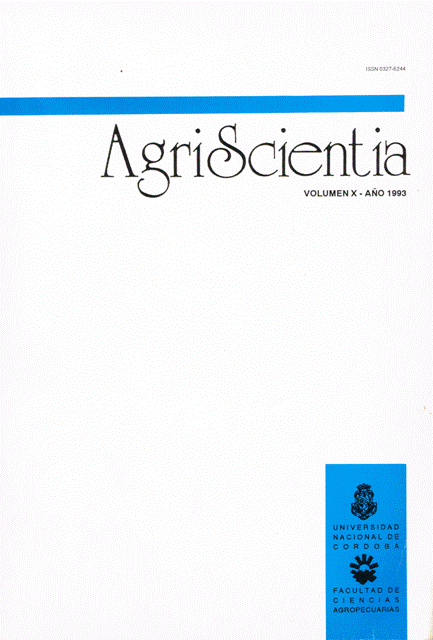Comparison between quasi-homologous agroclimates in the province of Córdoba based on risk attributes
Main Article Content
Abstract
Different agroclimatic classifications show a homogeneous behavior in the semiarid lands of Córdoba Province. This is the situation between Río II County and Río IV County, which, despite sharing some similar agroclimatic characteristics, present differences in relation to the productivity of cereal crops and the associated risk of extensive agriculture. A methodology to compare the productivity behavior between both counties is proposed for corn and sorghum crops, using an agroclimatic index that integrates the available effective rainy period. The major agricultural risk factor at Río II is amplified through a smaller intercept due to a higher number of failed cycles and a greater dependence on the availability of effective rainfall to ensure higher yields. Significant statistical differences were observed between both counties for both crops, but sorghum showed the most independent behavior regarding the hydrologic input.
Article Details

This work is licensed under a Creative Commons Attribution-ShareAlike 4.0 International License.
How to Cite
References
De la Casa, A. C. (1985). La deficiencia del agua en el suelo con respecto al cultivo del maíz en la región semiárida de la provincia de Córdoba. Actas III Reunión Argentina de Agrometeorología, 133-148. Córdoba.
De la Casa, A. C. (1986). Estudio agroclimático de la región semiárida de la provincia de Córdoba (Informe final Beca de Iniciación CONICET). Inédito.
De la Casa, A. C., & Rodríguez, A. R. (1994). Zonificación agroclimática de la provincia de Córdoba. Tercera parte: Sistemas agrícolas sugeridos y sus riesgos climáticos asociados. Resumen remitido a la VI Reunión Argentina de Agrometeorología.
De Fina, A. L. (1992). Aptitud agroclimática de la República Argentina. Academia Nacional de Agronomía y Veterinaria.
Moore, F., De la Casa, A. C., Rodríguez, A. R., & Sánchez, G. (1991). Zonificación agroclimática de la provincia de Córdoba. Segunda parte: Sistema administrativo de datos y generación de información agroclimática. Actas Segundo Encuentro Académico Tecnológico, IBM-UNC: 102 págs.
Prego, A. J. (1963). Las tierras áridas y semiáridas de Argentina. Informe Nacional. IDIA, 163.
Reddy, S. J. (1983a). Agroclimatic classification of the semiarid tropics: I. A method for the computation of classificatory variables. Agricultural Meteorology, 30, 185-200.
Reddy, S. J. (1983b). Agroclimatic classification of the semiarid tropics: II. Identification of classificatory variables. Agricultural Meteorology, 30, 201-219.
Reddy, S. J. (Ed.). (1993). Agroclimatic/Agrometeorological techniques: As applicable to dry-land agriculture in developing countries. S. Jeevananda Reddy. 205 págs.
Rodríguez, A. R., & De la Casa, A. C. (1990). Regiones hídricas de la República Argentina. Revista de Ciencias Agropecuarias, VII, 31-40.
Sierra, E. M., & Pórfido, O. D. (1980). Factores que afectan los rendimientos en la región maicera argentina. Revista de la Facultad de Agronomía, 1(2), 49-64.
Sivakumar, M. V. K. (1988). Predicting rainy season potential from the onset of rains in Southern Sahelian and Sudanian climatic zones of West Africa. Agricultural and Forest Meteorology, 42, 295-305.
Viglizzo, E. F. (1989). La interacción sistema-ambiente en condiciones extensivas de producción (Conferencia). Revista Argentina de Producción Animal, 9(4), 279-294.





